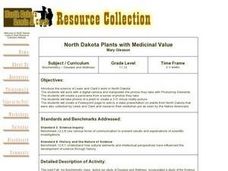Curated OER
After the American Revolution: Free African Americans in the North
Eleventh graders explore how one-third of Patriot soldiers at the Battle of Bunker Hill were African Americans Census data also reveal that there were slaves and free Blacks living in the Nort
Curated OER
Regions of North America:The Chesapeake Bay
In this Chesapeake Bay activity, learners read a 1-page article about the region and then respond to 5 fill in the blank and 3 short answer questions.
Curated OER
South American Outline Map
In this blank outline map worksheet, students study the political boundaries of the continent of North America and those of the countries located there.
National Endowment for the Humanities
Life Before the Civil War
American life before the Civil War was very different from American life today. To show this difference in a full spectrum, learners compare two communities that illustrate the differences between Northern and Southern life. Throughout...
Smithsonian Institution
World War I
How did World War I effect the United States' status as a world power? Pupils examine a website to learn many interesting facts about American involvement during World War I. They read passages and interact with artifacts in an online...
National Endowment for the Humanities
The War in the South, 1778–1781
The second in a three-part look at the Revolutionary War focuses the years from 1778 through 1781 and zooms in on military operations in the southern colonies, the French alliance, and the role African-Americans played in events. Class...
Carolina K-12
Affrilachia
What makes a culture unique? Learners research life in the Appalachia region of the United States. Poetry, music, and oral history create Affrilachia, the term used to describe the lifestyle of the area. African-American mountain culture...
Carolina K-12
The Results are In! Examining Our First Vote Election
The 2016 election is over, and now it's time to dig in to some data! An activity revolves around data gathered from the First Vote Project in North Carolina wherein thousands of students voted. After diving in to the data using provided...
PBS
Breaking the Code: Actions and Songs of Protest
Ezell Blair, Jr., David Richmond, Franklin McCain and Joseph McNeil changed history. Their sit-in at the lunch counter of the Woolworths in Greensboro, North Carolina on February 1, 1960 became a model for the nonviolent protests that...
Curated OER
1704 Attack on Deerfield
Class groups examine conflicting primary and secondary sources describing the 1704 attack on the fort at Deerfield by French and Native Americans and analyze the implications of discrepancies.
Curated OER
Queen Anne's War and Its Impact on Deerfield
Class members read a series of primary and secondary source materials to examine the effects of Queen Anne's War, also know as the War of Spanish Succession, on the Pocumtucks and other Native Americans in the area of Deerfield, MA.
Jamestown-Yorktown Foundation
How Did Relations between Britain and the Colonies Change after the French and Indian War?
What does the French and Indian War have to do with the American Revolution? Following the war, Britain issued the Proclamation of 1763 in an attempt to limit the colonists' western expansion. To understand how the proclamation, the...
Center for History Education
How Did the Public View Women’s Contributions to the Revolutionary War Effort?
Calling upon the legacies of Joan of Arc, Elizabeth I, and Catherine the Great, Esther Reed rallied Southern women to support the American Revolution. Using a broadside by Reed and other primary sources, such as poetry, young historians...
Crafting Freedom
Thomas Day's Letter to His Daughter, Mary Ann
Why is a letter a better way to learn about a person than a different primary source? Explore Thomas Day's ideas and advice to his daughter in a letter from 1851, which details the struggles of the American South before the Civil War....
Orlando Shakes
The Best of Enemies
History comes to life with the play The Best of Enemie. Scholars learn literary elements as well explore racial issues in American history. The play is based on a true story and addresses the universal truth that people are capable of...
Curated OER
Before Brother Fought Brother: People and Places in the North and South
Learners use census records to research and compare the population and economies in two counties within the same valley (Franklin Country Pennsylvania (North) and Augusta County, Virginia (South) in the pre Civil War era.
Curated OER
Data Comparison And Interpretation: North Korea, South Korea, And the United States
Ninth graders brainstorm "what they know about North Korea and South Korea." They determine the approximate distance from the United States to North and South Korea and create a graph comparing the birth rates, death rates, infant...
Curated OER
North Dakota Plants with Medicinal Value
Students use the internet and plant guides and other resources to identify plants and their medicinal importance as seen by the Native Americans. They view a copy of the Lewis and Clark journal that held photos of the plants of their...
Curated OER
Native American Three Sisters Gardens
Learners investigate companion planting. In this communtiy gardening lesson students explore the tradition of the Native American Three Sisters gardening approach. Learners act as botanists, anthropologists, folklorists, and curators.
Curated OER
American Culture in a Musical Setting
Students discover the significance of similarities and contrasts of three separate cultures of the United States through music. They take out maps and trace the expedition of the Spanish along the coasts of Mexico and North and South...
Scholastic
Harriet Tubman Follow the North Star
Honor Black History Month with a spotlight feature on Harriet Tubman. After learning about the path the Underground Railroad followed, scholars imagine themselves on it, and share their experience and feelings through writing.
Curated OER
Migration Waves
Learners examine how migration waves impacted Native American history. They listen to a lecture and take notes, read and discuss handouts in small groups, and create a group table that illustrates the differences and similarities between...
Curated OER
Early Native Americans
Fourth graders locate on a globe where the land bridge was. They describe the progression of nomadic people into North America.
Curated OER
Native American Project
Students explore the influences that geography has on a Native American tribe's culture and lifestyle. They examine how the first encounters with Europeans affected that tribe.
Other popular searches
- American North
- North American Geography
- North American Biomes
- North American Indians
- North American History
- North American Deserts
- North American Map
- North American Indian Tribes
- North American Climate Zones
- North American Explorers
- North American Dream
- North American History Skits

























